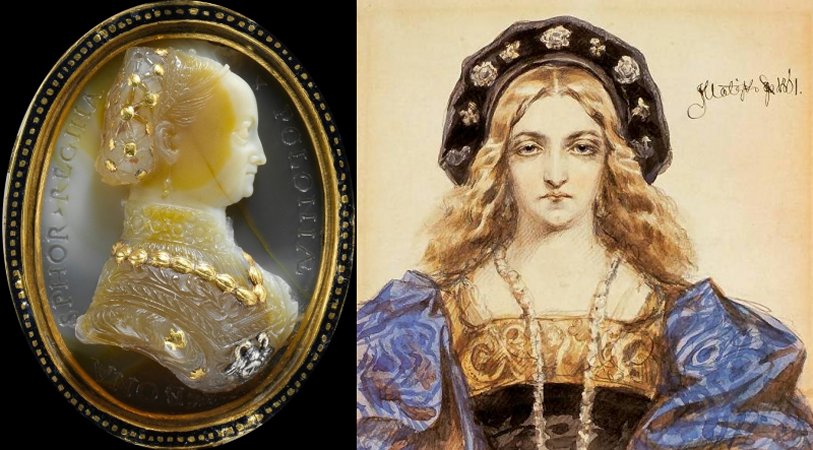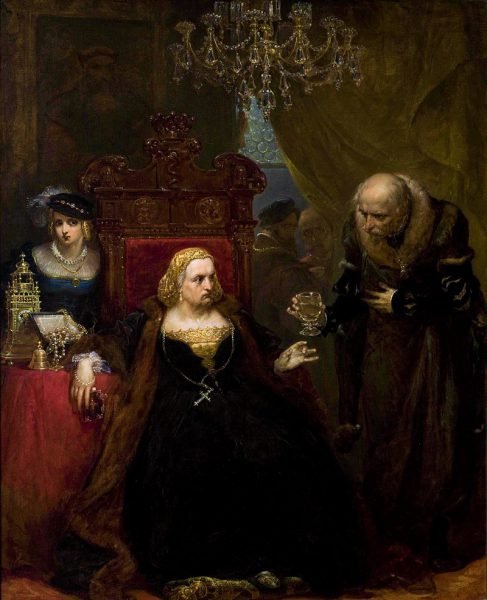Bona Sforza – Ambitious Queen Of Poland Was Betrayed And Murdered
Ellen Lloyd - AncientPages.com - It was said that she had a nasty habit of interfering with everything. She was outspoken, full of energy, and hot-tempered. Bona Sforza has gone to the history books as an admired but also criticized woman who was cunning and intelligent, and there is no doubt that her strong personality gave her supporters as well as enemies.
Cameo with bust of Bona Sforza, circa 1540. Credit: Public Domain. Right: Drawing of Bona Sforza. Credit: yourcracow. pl
Personal tragedies followed in her footsteps. Her desire to gain power and wealth was why her life ended in disaster. Those she trusted were also those who betrayed her.
Early Years Of Queen Bona Sforza
Bona Sforza was an Italian woman who became Queen of Poland through her marriage to Sigismund I. Since Sigismund I was also Grand Duke of Lithuania, Bona Sforza gained an extra title and became Grand Duchess of Lithuania. However, her way to the throne was long, and she had to overcome many obstacles before enjoying wealth and power.
Bona was born in 1494 in Milan, Italy. She was the daughter of Duke Gian Galeazzo Sforza and Dutchess Isabella of Naples. Such influential parents seemed ideal for a child-like Bona, but fate decided against her. According to rumors, her father was poisoned the same year Bona was born. She had to move with her mother, brother, and sisters to Sforza Castle in Milan, where they lived under the protection of Ludovico il Moro, Bona's father's uncle.
Ludovico il Moro was no real friend of the family. Living under his protection was more like spending time in prison, and he was constantly afraid Milan residents would rebel and install Francesco Sforza, the favored son of Gian Galeazzo. To be on the safe side, Ludovico il Moro separated Bona's brother from the family and sent him away.
King Sigismund I of Poland. Credit: Marcello Bacciarelli, Wikipedia
Things didn't go quite as Ludovico il Moro planned because the Italian War broke out in 1499. King Louis XII of France deposed Ludovico il Moro and took Gian Galeazzo to Paris.
Bona's Marriage To Polish King Sigismund I The Old
Now, Bona's mother felt there was a need to leave Milan, and she took Bona to the Castello Normanno-Svevo in Bari, where they made a home for themselves. Bona started her education, but her mother, Isabella, was restless and frustrated. All her children had died, and Bona was the only one she had left.
Isabella was determined to find a suitable candidate who could marry her daughter. It should be an ideal man who could give her money and power. There were several marriage proposals, and finally, Bona's old teacher, Crisostomo Colonna, convinced the widowed Polish King Sigismund I the Old to marry Isabella's daughter.
The wedding took place on April 15, 1518, just outside Kraków, Poland. At the time, King Sigismund I 's marriage was 51 years old, and Bona was 24 years old. The age difference was not the only reason the couple was not a perfect match. The Polish King was calm and valued comfort, while Bona was a woman full of energy who loved the entertainment.
Queen Bona's gardens at the Wawel Castle. Credit: Wikipedia, CC BY 2.5
A hunting accident led to a tragedy that affected the lives of her entire family. In 1527, while being pregnant, she was attacked by a bear she was chasing. Bona fell off her horse and lost her unborn child. Later, she became pregnant and gave birth to a boy named Olbracht, who died on the same day.
Bona Sforza Was A Queen Who Had Many Opinions And Forced The Polish King To Do What She Wanted
As Queen of Poland, Bona Sforza was involved in various state affairs from the beginning. It was by no means unusual that she and King Sigismund I disagreed. Still, in the end, Bona always decided how they would proceed. She "forced" her husband to accept her ideas and decisions. She could shout, cry, or use another persuasive method to get what she wanted.
Of course, Bona was no bad wife either. She cared for and nursed her husband when he was sick, but she was ambitious, intelligent, and well-educated. Bona was familiar with several foreign languages and knew politics, history, mathematics, geography, and theology.
Bona was not a queen who would sit on the throne doing nothing. She wanted to gain absolute power and become a person of actual influence. The Queen of Poland was a fierce opponent of the House of Habsburg, also called the House of Austria. Her opinion was that her country should instead seek a closer alliance with the Kingdom of France.
Poisoning of Queen Bona painted by Jan Matejko, 1859. Credit: Public Domain
Bona had a good relationship with Pope Leo X, who granted her the privilege of awarding benefices in several Polish cathedrals. This privilege gave her the perfect opportunity to secure the support of various officials. Three of her most trusted supporters, Piotr Kmita Sobienski, Andrzej Krzycki, and Piotr Gamrat, were sometimes known as the Triumvirate.
Bona Sforza was not a Polish woman by birth, but she loved Poland and wanted the best for the country. One of her goals was strengthening the royal dynasty's position in Poland.
Bona paid little attention to her three daughters, who we today know as Sophia, Duchess of Brunswick-Lüneburg, Anna I of Poland, and Catherine, Queen of Sweden. Their great and powerful mother completely overshadowed them.
Queen Bona Sforza was much more interested in the well-being and political success of her son, Sigismund II Augustus of Poland.
Bona even pressured her husband to crown their 10-year-old son while King Sigismund I was still alive. Of course, King Sigismund I, who was under pressure, agreed to his wife's wishes. It was a very unusual crowning, but Bona wanted to be sure no one questioned her son's future authority as ruler when her husband passed away.
Betrayal By One Of Her Own Led To Her Death
The queen's situation changed when King Sigismund I died on April 1, 1548. Bona moved to Masovia in Poland, where she stayed for eight years. Bona's contact with her son Sigismund II Augustus of Poland could have been better, and she was very disappointed in him. Bona disliked his marriage to Elisabeth Habsburg. When Elizabeth died, King Sigismund II Augustus married Barbara Radziwill, whom Bona disliked. When Barbara died of cancer, there were rumors the Polish King's wife had been poisoned by his mother. There is no evidence, but this event led to Bona's decision to leave Poland and move back to Bari.
Queen Bona Sforza's ending was somewhat controversial. On November 19, 1557, she was poisoned by her trusted officer, Gian Lorenzo Pappacoda. Pappacoda acted on behalf of King Philip II of Spain, who was unwilling to pay back an enormous debt to Bona.
The outspoken Polish Queen, famous for having an opinion about almost everything, was buried in St. Nicholas' Basilica in Bari.
Written by Ellen Lloyd – AncientPages.com
Updated on February 2, 2024
Copyright © AncientPages.com All rights reserved. This material may not be published, broadcast, rewritten or redistributed in whole or part without the express written permission of AncientPages.com
Expand for referencesBogucka M. - Bona Sforza
British Museum. Dept. of Manuscripts - Miniatures and Borders From the Book of Hours of Bona Sforza, Duchess of Milan, in the British Museum
More From Ancient Pages
-
 Three Punic Wars Between Rome And Carthage Lasted Almost A Hundred Years
Featured Stories | Apr 29, 2019
Three Punic Wars Between Rome And Carthage Lasted Almost A Hundred Years
Featured Stories | Apr 29, 2019 -
 10 Christian Symbols Explained
Ancient Symbols | Jul 28, 2018
10 Christian Symbols Explained
Ancient Symbols | Jul 28, 2018 -
 Mysterious Pyramid-Shaped Tomb Discovered In China
Archaeology | Mar 15, 2017
Mysterious Pyramid-Shaped Tomb Discovered In China
Archaeology | Mar 15, 2017 -
 Mysterious Ancient Underwater Structure Beneath MacDonald Lake Reveals Traces Of A Lost Civilization In Ontario
Civilizations | Nov 15, 2018
Mysterious Ancient Underwater Structure Beneath MacDonald Lake Reveals Traces Of A Lost Civilization In Ontario
Civilizations | Nov 15, 2018 -
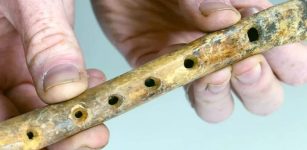 Rare, Well-Preserved Medieval Bone Flute Found In Kent
Archaeology | Nov 24, 2022
Rare, Well-Preserved Medieval Bone Flute Found In Kent
Archaeology | Nov 24, 2022 -
 Mysterious Maya Snake Kings And Their Powerful Kingdom In The Jungle Reveal More Ancient Secrets
Civilizations | Apr 23, 2018
Mysterious Maya Snake Kings And Their Powerful Kingdom In The Jungle Reveal More Ancient Secrets
Civilizations | Apr 23, 2018 -
 What Can Monument 9 Reveal About The Mysterious Olmec Civilization?
Featured Stories | Jun 30, 2023
What Can Monument 9 Reveal About The Mysterious Olmec Civilization?
Featured Stories | Jun 30, 2023 -
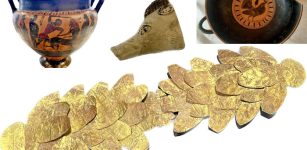 15 Precious Ancient Objects Returned To Greece From Switzerland – Antique Dealer Charged With Trafficking
Artifacts | Feb 3, 2023
15 Precious Ancient Objects Returned To Greece From Switzerland – Antique Dealer Charged With Trafficking
Artifacts | Feb 3, 2023 -
 Mysterious Osirion Of Abydos Egypt – Was It An Ancient Energy Plant?
Featured Stories | Feb 26, 2020
Mysterious Osirion Of Abydos Egypt – Was It An Ancient Energy Plant?
Featured Stories | Feb 26, 2020 -
 Mystery Of Ancient Sami People Buried Underwater – New DNA Breakthrough
Archaeology | Jun 12, 2019
Mystery Of Ancient Sami People Buried Underwater – New DNA Breakthrough
Archaeology | Jun 12, 2019 -
 Curious Celestial Boats, Knowledge Of Time Travel And Time Dilation In The Egyptian Papyrus Of Ani And Nu?
Ancient Technology | Aug 5, 2017
Curious Celestial Boats, Knowledge Of Time Travel And Time Dilation In The Egyptian Papyrus Of Ani And Nu?
Ancient Technology | Aug 5, 2017 -
 What Can The 3D Reconstruction Of The Principia At Novae Reveal About Roman Propaganda?
News | Sep 16, 2023
What Can The 3D Reconstruction Of The Principia At Novae Reveal About Roman Propaganda?
News | Sep 16, 2023 -
 Ancient Roman Altarpieces Deciphered And New Roman Goddess Uncovered In The Netherlands
Archaeology | Jun 18, 2024
Ancient Roman Altarpieces Deciphered And New Roman Goddess Uncovered In The Netherlands
Archaeology | Jun 18, 2024 -
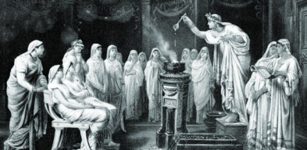 Ancient Romans Loved White Teeth – All Means Were Acceptable To Get Them Even Portuguese Urine
Ancient History Facts | Dec 10, 2017
Ancient Romans Loved White Teeth – All Means Were Acceptable To Get Them Even Portuguese Urine
Ancient History Facts | Dec 10, 2017 -
 47,000 Years Of Aboriginal Heritage Was Destroyed In Mining Blast – Results From Juukan Gorge Show
Featured Stories | Jul 22, 2024
47,000 Years Of Aboriginal Heritage Was Destroyed In Mining Blast – Results From Juukan Gorge Show
Featured Stories | Jul 22, 2024 -
 DNA Study Of Ice Age Survivors Reveals A Surprise About The Gravettian Culture
Archaeology | Mar 1, 2023
DNA Study Of Ice Age Survivors Reveals A Surprise About The Gravettian Culture
Archaeology | Mar 1, 2023 -
 Yu Shi ‘The Master Of Rain’ Revered Deity In Chinese People’s Beliefs
Featured Stories | Mar 2, 2024
Yu Shi ‘The Master Of Rain’ Revered Deity In Chinese People’s Beliefs
Featured Stories | Mar 2, 2024 -
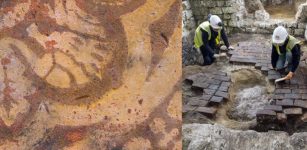 Strange Mythical Creature Resembling A Sphinx Discovered In A Medieval Bathroom
Archaeology | Mar 10, 2020
Strange Mythical Creature Resembling A Sphinx Discovered In A Medieval Bathroom
Archaeology | Mar 10, 2020 -
 The Untold Story Of The Inca – Mysterious Place Of The Raised Stones – Part 2
Civilizations | Jul 5, 2019
The Untold Story Of The Inca – Mysterious Place Of The Raised Stones – Part 2
Civilizations | Jul 5, 2019 -
 Durendal – Magical Sword Of Knight Roland That Cut Stone Boulders With A Single Strike
Featured Stories | Jan 19, 2022
Durendal – Magical Sword Of Knight Roland That Cut Stone Boulders With A Single Strike
Featured Stories | Jan 19, 2022

